HTML VS XHTML - What is the Difference between HTML and XHTML
Differences Between HTML and XHTML
- HTML, which stands for HyperText Markup Language, is derived from SGML. XHTML, which stands for eXtensible Markup Language, is derived from XML.
- Developers utilize both of these programming languages to develop web applications or websites.
- Compared to the core characteristics, HTML is case-sensitive, less expensive, and uses simple text formatted code. While XHTML is not case-sensitive, it is more costly than HTML and uses XHTML and XML as the application code.

What is HTML
- Tim Berners-Lee proposed HTML and W3C, and WHATWG developed them. HTML was released in 1993 and has undergone extensions from SGML. The filename extension of HTML is .html and .htm.
- The last release of HTML is HTML5, which is a major release for HTML in the year 2014. HTML can be embedded with CSS (Cascading style sheet) and JavaScript. HTML consists of elements; these elements define the structure of HTML pages.
- You can develop HTML pages using HTML editors such as Notepad on Windows machines and Text Edit on Mac Book or Mac machines.
- The basic HTML page structure consists of
- 1. Doctype tag like <!DOCTYPE html>, which describes the HTML version written.
- 2. HTML Root Element tag like <html></html>, which has all the code written for the web page.
- 3. Head element tag like <h1></h1>, in this title and heading is described.
- 4. Body element tag like <body></body>, it holds the content of the document.
Sample Code
<!DOCTYPE html>
<html lang="en">
<head>
<title>Kaashiv Infotech</title>
</head>
<body>
<b><i>Welcome To Wikitechy</b></i>
</body>
</html>
Output
Welcome To WikitechyWhat is XHTML
- World Wide Web Consortium developed XHTML, which was released in 2000. It has been extended from XML and HTML. The filename extension of XHTML is .xhtml and .xht. The last release of XHTML is XHTML5, which is being developed as XML configured with HTML5 specifications.
- XHTML-developed pages can use existing or new browsers and XML tools to view, edit, and validate them easily. They maintain compatibility with all browsers and seamlessly integrate with scripts and applets based on HTML and XML document object models.
- It is fast, accurate, easily maintained, editable, convertible, and formatted. It always provides a consistent and well-defined structure format for web pages that browsers can easily process.
- XHTML syntax closely resembles HTML syntax, but it maintains some key distinctions. XHTML structure closely resembles HTML structure, but it enforces case sensitivity, necessitates modifications to added attributes, and prohibits tag shortcuts. Proper structure and nested tags are imperative in XHTML.
Sample Code
<?xml version="1.0 encoding="UTF-8"?>
<!DOCTYPE html PUBLIC "-//W3C//DTD XHTML 1.0 Transitional//EN"
"http://www.w3.org/TR/xhtml1/DTD/xhtml1-transitional.dtd">
<html xmlns="http://www.w3.org/1999/xhtml">
<head>
<title>Kaashiv Infotech</title>
</head>
<body>
<b><i>Welcome To Wikitechy</i></b>
</body>
</html>
Output
Welcome To WikitechyHead to Head Comparison between HTML vs XHTML Infographic
Below are the top 8 Comparisons between HTML and XHTML :
1. Abbrevation
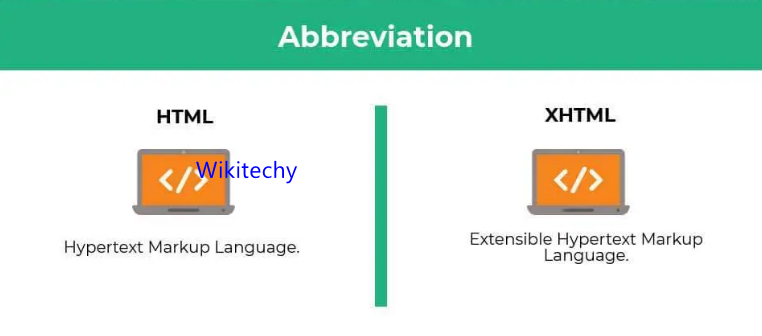
The abbreviations HTML and XHTML stand for the following:
- HTML: HyperText Markup Language
- XHTML: Extensible HyperText Markup Language
2. Case Sensitive
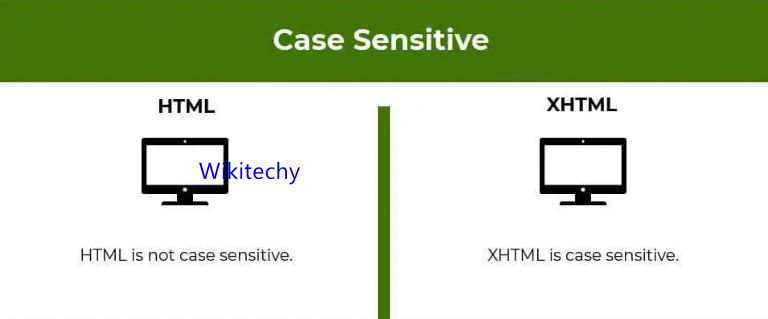
In terms of tag and attribute names, there is a crucial difference between HTML and XHTML when it comes to case sensitivity:
- HTML:
- Tag and attribute names are case-insensitive. In HTML, tag and attribute names can be written in uppercase, lowercase, or a mix of both, and they are treated the same way by web browsers. For example, <div>, <DIV>, and <DiV> are all interpreted as the same tag in HTML.
- XHTML:
- Tag and attribute names are case-sensitive. In XHTML, tag and attribute names must be written in the correct case. For example, <div> and <DIV> are considered different tags in XHTML. Mixing cases in XHTML may result in validation errors.
This case sensitivity in XHTML is one of the key differences from HTML, where developers must be consistent in their use of uppercase and lowercase letters in tag and attribute names to ensure proper rendering and validation of XHTML documents.
3. Internet Media Type
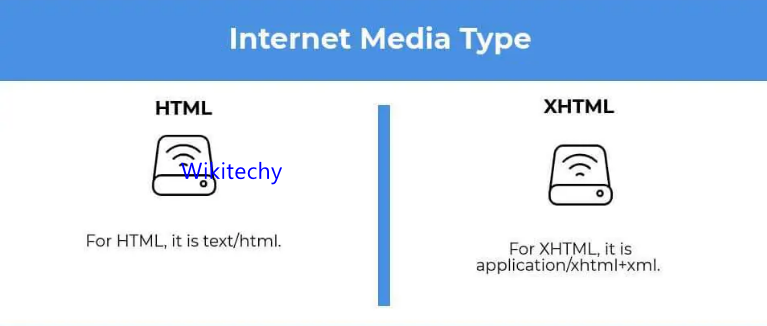
The Internet Media Type, also known as the MIME type, for HTML and XHTML documents is as follows:
- HTML (Hypertext Markup Language):
- MIME Type: text/html
- XHTML (Extensible Hypertext Markup Language):
- MIME Type: application/xhtml+xml
- These MIME types are used by web servers to indicate the type of content being served to web browsers and other user agents.
- HTML documents are typically served with the text/html MIME type, whereas XHTML documents, due to their XML-based structure, are served with the application/xhtml+xml MIME type.
- Serving XHTML with the correct MIME type is important for ensuring proper rendering and interpretation by web browsers.
4. Expressive
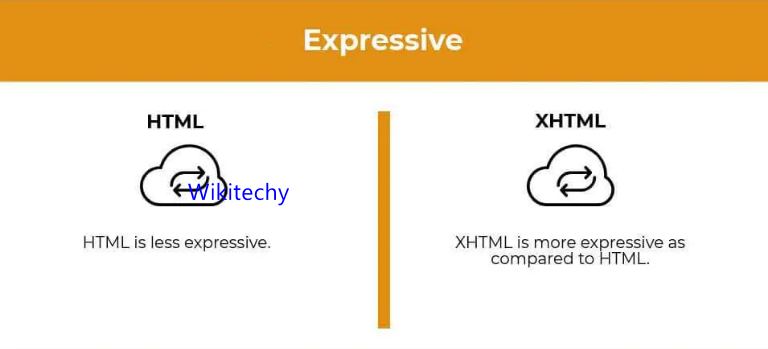
HTML (Hypertext Markup Language) and XHTML (Extensible Hypertext Markup Language) are both expressive in the sense that they allow web developers to create rich and interactive web content. However, there are some differences in how they express and structure web documents:
1. HTML (Hypertext Markup Language):
- Less Strict Syntax:
- HTML has a more forgiving and lenient syntax compared to XHTML. It can tolerate errors, and missing elements such as <!DOCTYPE>, <html>, <head>, and <body> are often automatically inferred by browsers.
- Case Insensitivity:
- HTML is not case-sensitive when it comes to tag and attribute names. You can use uppercase, lowercase, or mixed-case tags and attributes, and they will be interpreted the same way.
- Self-Closing Tags:
- In HTML, some tags like <br>, <img>, and <input> can be self-closed (e.g., <br> or <br />).
- Quotation Marks:
- Attribute values in HTML don't require quotation marks (e.g., <input type=text>).
- Error Tolerance:
- HTML is more tolerant of minor syntax errors and can still render a page even if there are issues.
2. XHTML (Extensible Hypertext Markup Language):
- Strict Syntax:
- XHTML follows a stricter syntax, requiring all tags to be properly nested and closed, and attribute values must be enclosed in quotation marks.
- Case Sensitivity:
- XHTML is case-sensitive for both tag and attribute names, requiring consistent casing (e.g., <div> and <DIV> are treated differently).
- Self-Closing Tags:
- In XHTML, self-closing tags must end with a slash (e.g., <br />, <img />).
- Quotation Marks:
- All attribute values in XHTML must be enclosed in quotation marks (e.g., <input type="text">).
- Error Handling:
- XHTML is less forgiving of syntax errors. Even minor issues can cause the entire document to fail to render.
In terms of expressiveness, both HTML and XHTML can be used to create a wide range of web content and applications. The choice between them often depends on project requirements and considerations such as compatibility, validation, and adherence to web standards. While HTML is more forgiving and widely supported, XHTML is preferred in environments where strict XML validation is necessary.
5. Application
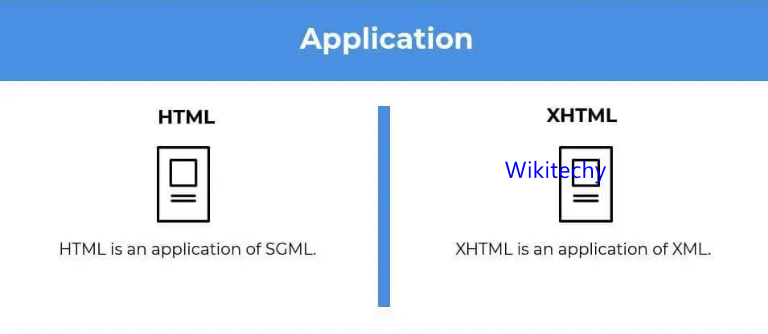
HTML (Hypertext Markup Language) and XHTML (Extensible Hypertext Markup Language) are both derived from SGML (Standard Generalized Markup Language) and XML (eXtensible Markup Language), but they have different syntax and applications. Let's compare their applications in the context of SGML and XML:
1. HTML (SGML Application):
- SGML-Based:
- Traditional HTML is based on SGML, a flexible and complex markup language that allows the definition of custom document types.
- Forgiving Syntax:
- HTML, based on SGML, has a forgiving syntax. It can tolerate minor errors and inconsistencies, making it accessible for beginners and allowing for more leniency in document structure.
- Common Usage:
- HTML, based on SGML, is widely used for creating web pages and web applications. It is the standard markup language for most web content.
2. XHTML (XML Application):
- XML-Based:
- XHTML is based on XML, a strict and well-defined markup language that enforces a consistent and rigorous document structure.
- Strict Syntax:
- XHTML has a stricter syntax compared to HTML. All tags must be properly nested and closed, and attribute values must be enclosed in quotes. XHTML documents must be well-formed XML documents.
- XML Compatibility:
- XHTML documents are also XML documents. This means they can be easily integrated with other XML technologies and processed using XML tools and parsers.
- Advanced Applications:
- XHTML is often used in advanced web applications, mobile applications, and in environments where integration with XML-based systems is necessary. It is suitable for projects requiring strict document structure and validation.
- Future Web Standards:
- XHTML was developed to be the successor to HTML, promoting a more structured, strict, and interoperable web. However, the adoption of XHTML as the primary web standard has diminished in favor of HTML5, which combines the flexibility of HTML with many features of XHTML.
In summary, HTML, based on SGML, is forgiving and widely used for general web development. XHTML, based on XML, is stricter and is often used in advanced applications and environments requiring strict document structure and XML compatibility. The choice between HTML and XHTML depends on specific project requirements and the desired level of strictness in document structure and validation. However, it's worth noting that HTML5 has largely replaced XHTML in modern web development due to its ease of use and flexibility.
6. Format
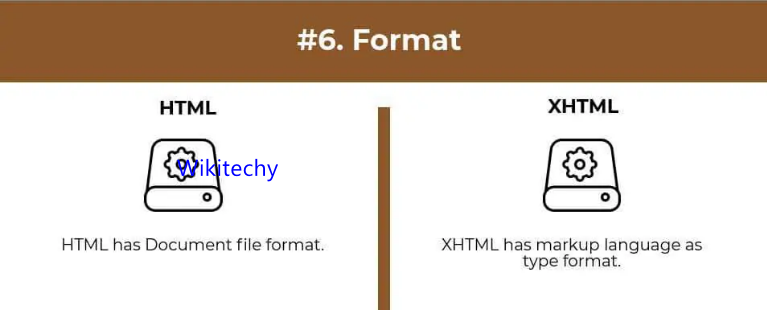
1. HTML Document File Format:
- The file format for HTML documents can vary, but it is typically saved with the file extension .html or .htm.
- For example, you might have files like index.html, about.html, or contact.htm.
2. XHTML Markup Language Type:
- XHTML itself is not a file format; it's a markup language based on XML. However, when you use XHTML for web documents, you would typically save them with the same file extensions as HTML files, such as .html or .htm.
So, in practical terms:
- When you create a web page using HTML, you save it with an .html or .htm file extension.
- When you create a web page using XHTML, you also save it with an .html or .htm file extension because XHTML documents are meant to be processed and served like HTML documents. The key difference is in the syntax and rules used within the document, not the file format.
In summary, both HTML and XHTML web documents are typically saved with the same file extensions, and the choice between them depends on the markup language and syntax rules you use within the document.
7.Parer
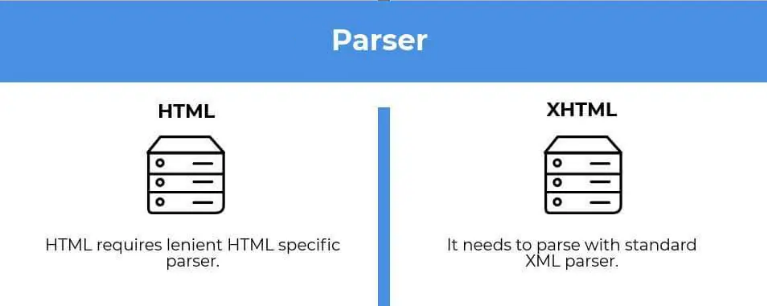
HTML parsers and XHTML parsers are software components or libraries designed to parse and process web documents written in HTML or XHTML, respectively. These parsers are used to extract structured information from web pages and enable web browsers and other software to render and interact with web content. Here's a comparison between HTML parsers and XHTML parsers:
1. HTML Parser:
- Forgiving Parsing: HTML parsers are designed to be forgiving and lenient in their parsing. They can handle imperfect or non-standard HTML code and still render a web page, even if there are minor syntax errors or unclosed tags.
- Tag and Attribute Insensitivity: HTML parsers are not case-sensitive for tag and attribute names, meaning they will treat <div> and <DIV> the same. Attribute values may also be unquoted in many cases.
- Self-Closing Tags: HTML parsers allow self-closing tags like <br> without requiring a trailing slash, although the slash is still accepted.
- Quirks Mode: Web browsers often switch to "quirks mode" when parsing HTML, which means they adapt to non-standard code to ensure backward compatibility.
2. XHTML Parser:
- Strict Parsing: XHTML parsers follow strict XML parsing rules. They require well-formed documents with correctly nested and closed tags, proper casing of tag and attribute names, and attribute values enclosed in quotes.
- Case Sensitivity: XHTML parsers are case-sensitive for both tag and attribute names, so <div> and <DIV> are considered different elements.
- Self-Closing Tags: Self-closing tags in XHTML must end with a trailing slash, as in <br />.
- XML Parsing: Since XHTML is based on XML, it is parsed using XML parsers, which enforce XML rules strictly.
In summary, HTML parsers are more forgiving and designed to handle non-standard or messy code, making them suitable for traditional HTML documents. On the other hand, XHTML parsers strictly adhere to XML rules, requiring well-formed documents and ensuring case sensitivity, making them suitable for documents that follow the XHTML standard. The choice between HTML and XHTML depends on the specific requirements of the project and the document structure.
8. Constraint
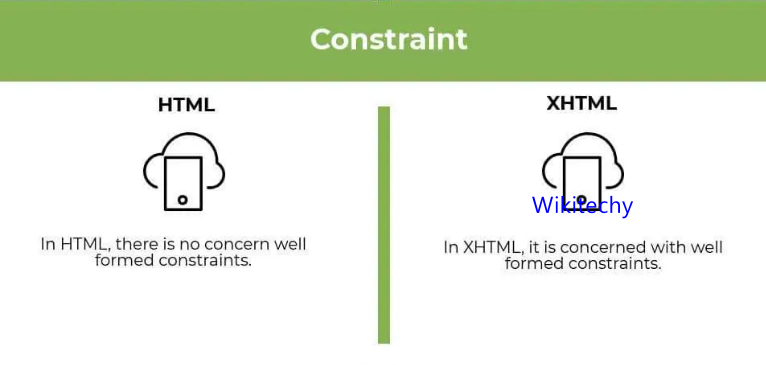
HTML (HyperText Markup Language) and XHTML (eXtensible HyperText Markup Language) are both markup languages used to create web pages. The primary difference between them lies in their syntax and rules.
- HTML Constraint:
- HTML has relatively lenient syntax rules, allowing developers to write code that might not be well-formed or strictly adhere to XML standards.
- This leniency can lead to inconsistencies in rendering web pages across different browsers and devices.
- HTML constraints are generally more forgiving, making it easier for developers to create web content but potentially causing issues with compatibility and future-proofing.
- XHTML Constraint:
- XHTML, on the other hand, is a stricter and more structured version of HTML.
- It follows the XML standards, meaning that the syntax rules are more rigid. XHTML documents must be well-formed, which requires adherence to specific guidelines such as proper nesting of tags, attribute quoting, and lowercase tag names.
- This strictness ensures consistency in rendering across different platforms and devices, making it easier to maintain and update web content.
Differences Between HTML vs XHTML
- In HTML, we can have empty or open tags means it is not required to end the tag, e.g., <p>. In XHTML, the tags should be closed or self-closed if opened g <p> </p> or <br/>
- In HTML, you place all the written text that needs to be displayed in the browser under the HTML body element. However, in XHTML, developers have the flexibility to organize the content into blocks.
- In HTML, While defining the attributes, mentioning quotes is unnecessary—E.g., <option selected>. In XHTML, while defining the attributes, it is mandatory to mention quotes. For e.g. <option selected=”Selected”>.
- In HTML, the values of attributes are not so important. E.g., <input type=” radiobutton” selected>. In XHTML, the values of attributes are important. For e.g. <input type=”radiobutton” selected=”selected”>.
- In HTML, there are no strict rules on writing the structure of elements, e.g., <p> <b> Hello world</p></b>. In XHTML, there are strict rules on writing structure elements, E.g., <p><b>Hello world</b></p>.
- You can describe the tags and attributes in HTML using lowercase or uppercase letters. In XHTML, the tags and attributes can be described in lowercase only.
- One root element is not mandatory in HTML, while the documents should have one root element in XHTML.
- In HTML, XML declaration is not necessary. In XHTML, it is based on the set of rules of XML.
HTML vs XHTML
| Section | HTML | XHTML |
|---|---|---|
| Syntax | HTML has a more lenient syntax and allows for more flexibility. | XHTML has strict XML syntax and requires well-formed markup. |
| Tags | HTML tags are case-insensitive and can be written in lowercase. | XHTML tags are case-sensitive and must be written in lowercase. |
| Attribute | HTML attributes can be written in a variety of formats. | XHTML attributes must have a specific format (e.g., name=”value”). |
| Self-closing | Some HTML tags can be self-closed, but it is not required. | XHTML requires all tags to be properly closed, including self-closing tags. |
| Namespace | HTML does not require a specific namespace declaration. | XHTML requires a namespace declaration (e.g., xmlns=”http://www.w3.org/1999/xhtml”). |
| Error handling | HTML is forgiving and can still render the page even with errors. | XHTML is unforgiving and strict, so even minor errors can break the page. |
| Compatibility | HTML is more compatible with older browsers. | XHTML requires stricter compliance and may not work well with older browsers. |
| Extensibility | HTML is less extensible and does not support modularization. | XHTML supports modularity and allows for easy integration with other XML technologies. |
| Abbreviation | Hypertext Markup Language. | Extensible Hypertext Markup Language. |
| Case Sensitive | HTML is not case-sensitive. | XHTML is case-sensitive. |
| Internet Media Type | For HTML, it is text/html. | For XHTML, it is application/xhtml+xml. |
| Expressive | HTML is less expressive. | XHTML is more expressive. |
| Application | HTML is an application of SGML. | XHTML is an application of XML. |
| Format | HTML has a Document file format. | XHTML has markup language as a type format. |
| Parser | HTML requires a lenient HTML-specific parser. | It needs to parse with a standard XML parser. |
| Constraint | In HTML, there is no concern for well-formed constraints. | In XHTML, it is concerned with well-formed constraints. |
| Rules | Here there are no strict rules for the elements and tags | Here we should follow the strict rulesConclusion |
| Attributes | The specified attribute values are not necessary. | The attribute values are necessary for entering. |
| Root elements | Root Elements are not necessary for the html tags. | Root Elements are necessary for the XHTML documents. |
